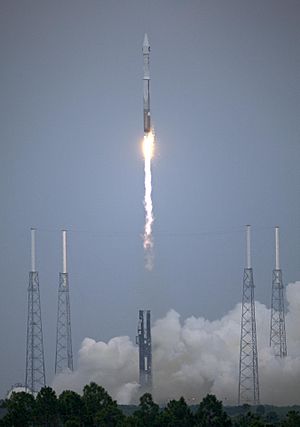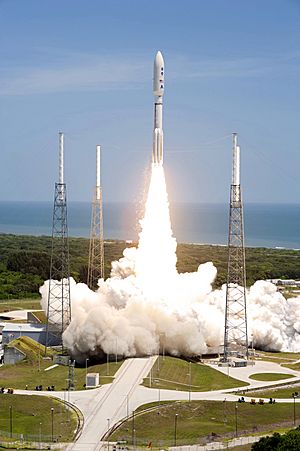Atlas V facts for kids

The Atlas V is a powerful rocket used to launch satellites into orbit. It was built by the United Launch Alliance, which is a company formed by Boeing and Lockheed Martin. This rocket stands about 58.3 meters tall and is 3.81 meters wide.
The Atlas V first flew on August 21, 2002. Since then, it has flown many times, carrying important missions into space. Unlike the Space Shuttle, each Atlas V rocket is used only once. A new rocket is built for every launch.
Contents
Famous Flights of the Atlas V
The Atlas V has launched many important missions into space. Some of the most famous ones include:
- New Horizons: This spacecraft flew past Pluto and beyond.
- Mars Science Laboratory: This mission carried the Curiosity rover to Mars.
- Juno: This probe is currently orbiting Jupiter.
- Mars Reconnaissance Orbiter: This satellite studies Mars from orbit.
- Lunar Reconnaissance Orbiter/LCROSS: These missions explored the Moon.
- Boeing X-37B: This is a reusable robotic spaceplane.
How Atlas V Rockets Are Named
The Atlas V has a special way of naming its different versions. This naming system helps you understand what kind of rocket it is:
- The first number tells you how wide the nose cone (called the fairing) is. A 400 series Atlas V has a 4-meter wide fairing. A 500 series Atlas V has a 5-meter wide fairing. The fairing protects the spacecraft during launch.
- The second number tells you how many extra solid rocket boosters are attached to the side. For example, an Atlas V 501 has no extra boosters. An Atlas V 421 has 2 extra boosters. These boosters give the rocket more power at liftoff.
- The last number tells you how many engines are on the second stage, called the Centaur. So far, all Atlas V rockets have used only one engine on the Centaur. However, future versions might use two engines.
There is also a special version called the HLV. It would have two extra first stages strapped on like boosters. But this version has not flown yet.
Parts of the Atlas V Rocket
The Atlas V rocket is made of a few main parts:
- First Stage: This is called the Common Core Booster. It uses a powerful RD-180 engine, which comes from Russia. Every Atlas V rocket uses this as its main first stage.
- Second Stage: This part is called the Centaur. It has one or two RL-10 engines, made by Aerojet Rocketdyne. The Centaur helps push the spacecraft the rest of the way into orbit.
- Payload Fairing: This is a protective cover on top of the rocket. It can be 4 or 5 meters wide. It keeps the spacecraft safe during the launch through Earth's atmosphere.
Images for kids
-
X-37B OTV-1 (Orbital Test Vehicle) being encased in its payload fairing for its 22 April 2010, launch.
-
An Atlas V 551 with the New Horizons probe launches from Launch Pad 41 in Cape Canaveral.
See also
 In Spanish: Atlas V para niños
In Spanish: Atlas V para niños









